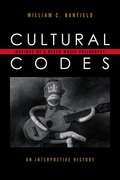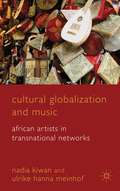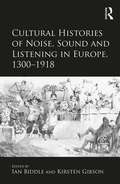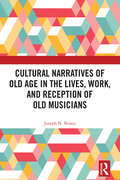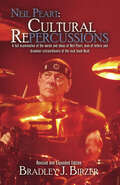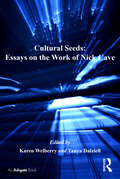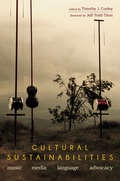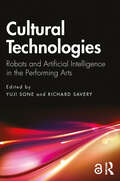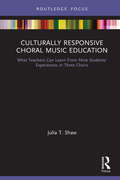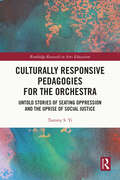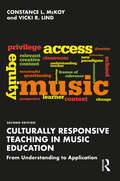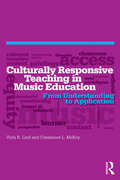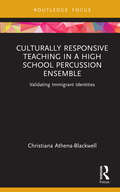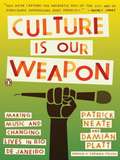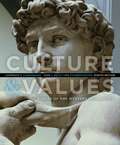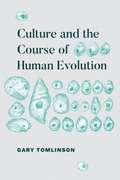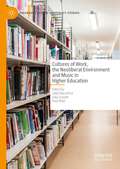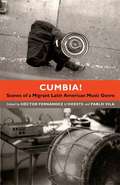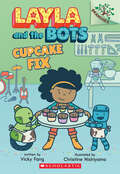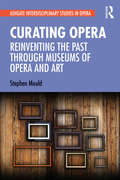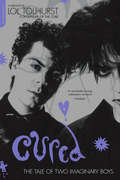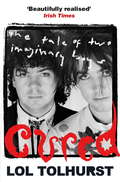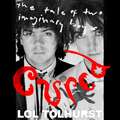- Table View
- List View
Cultural Codes: Makings Of A Black Music Philosophy - An Interpretive History From Spirituals To Hip Hop (African American Cultural Theory And Heritage Series)
by William C. Banfield Bill Banfield"No art can survive without an understanding of, and dedication to, the values envisioned by its creators. No culture over time has existed without a belief system to sustain its survival. Black music is no different. In Cultural Codes: Makings of a Black Music Philosophy, William C. Banfield engages the reader in a conversation about the aesthetics and meanings that inform this critical component of our social consciousness." <P><P>"By providing a focused examination of the historical development of Black music artistry, Banfield formulates a useable philosophy tied to how such music is made, shaped, and functions. In so doing, he explores Black music culture from three angles: history, education, and the creative work of the musicians who have moved the art forward. In addition to tracing Black music from its African roots to its various contemporary expressions, including jazz, soul, R&B, funk, and hip hop, Banfield profiles some of the most important musicians over the last century: W.C. Handy, Scott Joplin, Louis Armstrong, Duke Ellington, Count Basie, Mary Lou Williams, John Coltrane, James Brown, Jimi Hendrix, and Stevie Wonder, among others. Cultural Codes provides an educational and philosophical framework for students and scholars interested in the traditions, the development, the innovators, and the relevance of Black music."--BOOK JACKET.
Cultural Globalization and Music
by Nadia Kiwan Ulrike Hanna MeinhofThis book is about South-North, North-South relations between Africa and Europe, presenting the personal narratives of musicians in different locations across Africa and Europe, and those of the people who constitute their networks within the wider artistic, cultural, and civil society milieus of globalizing societies.
Cultural Histories of Noise, Sound and Listening in Europe, 1300-1918: )
by Ian Biddle Kirsten GibsonCultural Histories of Noise, Sound and Listening in Europe, 1300-1918 presents a range of historical case studies on the sounding worlds of the European past. The chapters in this volume explore ways of thinking about sound historically, and seek to understand how people have understood and negotiated their relationships with the sounding world in Europe from the Middle Ages through to the early twentieth century. They consider, in particular: sound and music in the later Middle Ages; the politics of sound in the early modern period; the history of the body and perception during the Ancien Régime; and the sounds of the city in the nineteenth century and sound and colonial rule at the fin de siècle. The case studies also range in geographical orientation to include considerations not only of Britain and France, the countries most considered in European historical sound studies in English-language scholarship to date, but also Bosnia-Herzegovina, British Colonial India, Germany, Italy and Portugal. Out of this diverse group of case studies emerge significant themes that recur time and again, varying according to time and place: sound, power and identity; sound as a marker of power or violence; and sound, physiology and sensory perception and technologies of sound, consumption and meaning.
Cultural Identity in British Musical Theatre, 1890–1939: Knowing One's Place (Palgrave Studies In British Musical Theatre Ser.)
by Ben MacphersonThis book examines the performance of ‘Britishness’ on the musical stage. Covering a tumultuous period in British history, it offers a fresh look at the vitality and centrality of the musical stage, as a global phenomenon in late-Victorian popular culture and beyond. Through a re-examination of over fifty archival play-scripts, the book comprises seven interconnected stories told in two parts. Part One focuses on domestic and personal identities of ‘Britishness’, and how implicit anxieties and contradictions of nationhood, class and gender were staged as part of the popular cultural condition. Broadening in scope, Part Two offers a revisionary reading of Empire and Otherness on the musical stage, and concludes with a consideration of the Great War and the interwar period, as musical theatre performed a nostalgia for a particular kind of ‘Britishness’, reflecting the anxieties of a nation in decline.
Cultural Moves: African Americans and the Politics of Representation
by Herman S. GrayHerman Gray takes a sweeping look at black popular culture over the past decade to explore culture's role in the push for black political power and social recognition. In a series of linked essays, he finds that black artists, scholars, musicians, and others have been instrumental in reconfiguring social and cultural life in the United States and he provocatively asks how black culture can now move beyond a preoccupation with inclusion and representation.
Cultural Narratives of Old Age in the Lives, Work, and Reception of Old Musicians
by Joseph StrausOperating largely within the world of European-American classical music, this book discusses the creative work of old musicians—composers, performers, listeners, and scholars—and how those forms of music- making are received and understood. Like everything else about old age, music-making is usually understood as a decline from a former height, a deficiency with respect to a youthful standard. Against this ageist mythology, this book argues that composing oldly, performing oldly, and listening oldly are distinctive and valuable ways of making music—a difference, not a deficit; to be celebrated, not ignored or condemned.Instead of the usual biomedical or gerontological understanding of old age, with its focus on bodily, cognitive, and sensory decline, this book follows Age Studies in seeing old age through a cultural lens, as something created and understood in culture. This book seeks to identify the ways that old musicians (composers, performers, listeners, and scholars) accept, resist, adapt, and transform the cultural scripts for the performance of old age. Musicking oldly (making music in old age) often represents an attempt to rewrite ageist cultural scripts and to find ways of flourishing musically in a largely hostile landscape.
Cultural Repercussions: Cultural Repercussions
by Bradley J. BirzerA revised & expanded examination of the words and ideas of the man of letters and drummer extraordinaire of the rock band Rush. In January 2020, the world lost not only one of the greatest drummers, but also one of the most insightful lyricists. And a brilliant writer. Though Neil Peart was universally lauded as drummer for legendary rock band Rush, few studies have been devoted to his writings. Yet, Peart was very much a man of his words. He wrote lyrics, travelogues, essays, cultural criticism, short stories, and fantasy novels. The themes in his writings are timeless: personal journeys, exploration, excellence, growth, philosophy, art, satisfaction and happiness, religion, politics, individualism, natural history, life, love, loss, redemption, and beauty. Peart wanted every person to persevere through individual trials, find unique gifts and abilities and, ultimately, true happiness. He did not just profess such things; he lived them. Never satisfied with second best or any form of defeat, Peart challenged himself to live up to his own philosophy. And he always succeeded with grace, which earned him even more fervent admirers. Since his death in 2020, Neil Peart has continued to inspire thousands through his music, his words, and his example. This book—revised and expanded to incorporate Peart&’s final years—carefully examines the influence that his life, his witness, and his words have had on others. Neil Peart lived life to the fullest, and he made us each better for it. &“Includes some of the strongest analysis of Peart&’s lyrics that you&’ll find, and does a rigorous job of nailing down the tenets of Peart&’s ever-evolving philosophy.&” —PROG Magazine
Cultural Seeds: Essays On The Work Of Nick Cave (Ashgate Popular and Folk Music Series)
by Karen Welberry Tanya DalziellNick Cave is now widely recognized as a songwriter, musician, novelist, screenwriter, curator, critic, actor and performer. From the band, The Boys Next Door (1976-1980), to the spoken-word recording, The Secret Life of the Love Song (1998), to the recently acclaimed screenplay of The Proposition (2005) and the Grinderman project (2008), Cave's career spans thirty years and has produced a comprehensive (and sometimes controversial) body of work that has shaped contemporary alternative culture. Despite intense media interest in Cave, there have been remarkably few comprehensive appraisals of his work, its significance and its impact on understandings of popular culture. In addressing this absence, the present volume is both timely and necessary. Cultural Seeds brings together an international range of scholars and practitioners, each of whom is uniquely placed to comment on an aspect of Cave's career. The essays collected here not only generate new ways of seeing and understanding Cave's contributions to contemporary culture, but set up a dialogue between fields all-too-often separated in the academy and in the media. Topics include Cave and the Presley myth; the aberrant masculinity projected by The Birthday Party; the postcolonial Australian-ness of his humour; his interventions in film and his erotics of the sacred. These essays offer compelling insights and provocative arguments about the fluidity of contemporary artistic practice.
Cultural Sustainabilities: Music, Media, Language, Advocacy
by Timothy J CooleyEnvironmental sustainability and human cultural sustainability are inextricably linked. Reversing damaging human impact on the global environment is ultimately a cultural question, and as with politics, the answers are often profoundly local. Cultural Sustainabilities presents twenty-three essays by musicologists and ethnomusicologists, anthropologists, folklorists, ethnographers, documentary filmmakers, musicians, artists, and activists, each asking a particular question or presenting a specific local case study about cultural and environmental sustainability. Contributing to the environmental humanities, the authors embrace and even celebrate human engagement with ecosystems, though with a profound sense of collective responsibility created by the emergence of the Anthropocene. Contributors: Aaron S. Allen, Michael B. Bakan, Robert Baron, Daniel Cavicchi, Timothy J. Cooley, Mark F. DeWitt, Barry Dornfeld, Thomas Faux, Burt Feintuch, Nancy Guy, Mary Hufford, Susan Hurley-Glowa, Patrick Hutchinson, Michelle Kisliuk, Pauleena M. MacDougall, Margarita Mazo, Dotan Nitzberg, Jennifer C. Post, Tom Rankin, Roshan Samtani, Jeffrey A. Summit, Jeff Todd Titon, Joshua Tucker, Rory Turner, Denise Von Glahn, and Thomas Walker
Cultural Technologies: Robots and Artificial Intelligence in the Performing Arts
by Yuji Sone Richard SaveryCultural Technologies: Robots and Artificial Intelligence in the Performing Arts presents a diverse range of perspectives from leading scholars and artists on contemporary performing arts practices that engage with robotic and AI (artificial intelligence) technologies.In Part One, "Robot/AI Cultures and Performing Arts Practices," contributors discuss how cultural understandings of robots and AI influence the audience’s reception of performance works that feature such technologies and inspire artistic innovation. The chapters in Part Two, "Performing Arts Cultures and Robots/AI Developments," explore how theories and practices of the performing arts can engender critical dialogue on matters of cultural difference concerning culturally non-specific (though implicitly Western) framings of robotic and AI technologies within science and engineering contexts.Reorienting the conversation around robotics and AI in the performing arts to place culture at its centre, Cultural Technologies: Robots and Artificial Intelligence in the Performing Arts offers thought-provoking analyses for advanced undergraduates, researchers, and performing arts practitioners interested in the relationships between music, theatre, and dance, and cutting-edge robotic and AI technologies.
Culturally Responsive Choral Music Education: What Teachers Can Learn From Nine Students’ Experiences in Three Choirs (Culturally Responsive Teaching in Music Education)
by Julia T. ShawCulturally Responsive Choral Music Education visits the classrooms of three ethnically diverse choral teacher-conductors to highlight specific examples of ways that culturally responsive teaching (CRT) can enrich choral music education. Principles of CRT are illustrated in contrasting demographic contexts: a choir serving a sizeable immigrant Hispanic population, a choir with an African American classroom majority, and a choir comprised of students who identify with eighteen distinct ethnicities. Additionally, portraits of nine ethnically diverse students illuminate how CRT shaped their experiences as members of these choral ensembles. Practical recommendations are offered for developing a culturally responsive classroom environment.
Culturally Responsive Pedagogies for the Orchestra: Untold Stories of Seating Oppression and the Uprise of Social Justice (Routledge Research in Arts Education)
by Tammy S. YiThis innovative volume explores the potential of alternative seating practices (ASP) to revolutionize orchestral music teaching in US schools and beyond by improving musicians’ social and musical experiences, including peer mentorship. Challenging traditional hierarchical seating structures and drawing on longitudinal research and autoethnographic data, it explores the benefits of alternative seating practices on student learning, well-being, and overall musical performance. Rooted in critical discussion of the importance of social justice in music education, it describes new strategies for culturally responsive pedagogies and examines how educators and conductors can create a cohesive and collaborative orchestra guided by the principles of ethnic studies, while valuing and celebrating diversity among the members. It will be of interest to academics, scholars, and educators in music education and pedagogy, social justice education, and race and ethnic studies.
Culturally Responsive Teaching in Music Education: From Understanding to Application
by Vicki R. Lind Constance L. McKoyCulturally Responsive Teaching in Music Education: From Understanding to Application, Second Edition, presents teaching methods that are responsive to how different culturally specific knowledge bases impact learning. It offers a pedagogy that recognizes the importance of including students’ cultural references in all aspects of learning. Designed as a resource for teachers of undergraduate and graduate music education courses, the book provides examples in the context of music education, with theories presented in Part I and a review of teaching applications in Part II. Culturally Responsive Teaching in Music Education is an effort to answer the question: How can I teach music to my students in a way that is culturally responsive? This book serves several purposes, by: Providing practical examples of transferring theory into practice in music education. Illustrating culturally responsive pedagogy within the classroom. Demonstrating the connection of culturally responsive teaching to the school and larger community. This Second Edition has been updated and revised to incorporate recent research on teaching music from a culturally responsive lens, new data on demographics, and scholarship on calls for change in the music curriculum. It also incorporates an array of new perspectives from music educators, administrators, and pre-service teachers—drawn from different geographic regions—while addressing the impact of the Covid-19 pandemic and the 2020 social justice protests.
Culturally Responsive Teaching in Music Education: From Understanding to Application
by Vicki R. Lind Constance McKoyCulturally Responsive Teaching in Music Education presents teaching methods that are responsive to how different culturally specific knowledge bases impact learning. It is a pedagogy that recognizes the importance of including students’ cultural references in all aspects of learning. Designed to be a supplementary resource for teachers of undergraduate and graduate music education courses, the book provides examples in the context of music education, with theories presented in Section I and a review of teaching applications in Section II. Culturally Responsive Teaching in Music Education is an effort to answer the question: How can I teach music to my students in a way that is culturally responsive? This book serves several purposes, by: • Offering theoretical/philosophical frameworks of social justice • Providing practical examples of transferring theory into practice in music education • Illustrating culturally responsive pedagogy within the classroom • Demonstrating the connection of culturally responsive teaching to the school and larger community
Culturally Responsive Teaching in a High School Percussion Ensemble: Validating Immigrant Identities (Routledge Focus on Music Education: Culturally Responsive Teaching)
by Christiana Athena-BlackwellCulturally Responsive Teaching in a High School Percussion Ensemble: Validating Immigrant Identities addresses themes of immigration, identity, and culturally responsive teaching in music education using a deep case study of Brazilian samba music in the context of a high school percussion ensemble.Through an in-depth ethnographic study of the World Percussion Ensemble at Somerville High School, Massachusetts, and how it was renovated by a progressive music program director, the author demonstrates how a program can respond to the cultures and needs of immigrant students by creating a unique intercultural community within the classroom. The book recognizes key components in the process of immigrant social integration: (1) music education can help facilitate immigrant students’ adjustment to a new culture as they negotiate a hybrid identity. (2) The inclusive nature of samba percussion music encourages communication, cooperation, and empathy, helping students to build life skills. (3) By blending rhythms from their countries of origin with a pop song of choice for their final composition, the students create their own interculture.Deriving from culturally responsive music teaching practices, this study will inspire music teachers and music education researchers to transfer some of the methods to center students’ languages, identities, and cultural references in their curricula.
Culture Is Our Weapon
by Patrick Neate Caetano Veloso Damian PlattAn inspiring mission to rescue young people from drugs and violence with music At a time when interest in Brazilian culture has reached an all-time high, and the stories of one person's ability to improve the lives of others has captured so many hearts, this unique book takes readers to the frontlines of a battle raging over control of the nation's poorest areas. Culture Is Our Weapon tells the story of Grupo Cultural AfroReggae, a Rio-based organization employing music and an appreciation for black culture to inspire residents of the favelas, or shantytowns, to resist the drugs that are ruining their neighborhoods. This is an inspiring look at an artistic explosion and the best and worst of Brazilian society.
Culture and Values: A Survey of the Humanities (8th Edition)
by Lois Fichner-Rathus Lawrence S. Cunningham John J. ReichCULTURE AND VALUES: A SURVEY OF THE WESTERN HUMANITIES takes you on a fascinating tour of some of the world's most significant examples of art, music, philosophy, and literature, from the beginnings of civilization to today. New features in the eighth edition are designed to make it easy for you to understand the influence of historical events and values on the works produced by each culture--guided discussions of all of the readings, chapter previews, timelines, "Compare and Contrast" sections, "Big Picture" reviews at the end of each chapter, and high-quality images with clear captions.
Culture and the Course of Human Evolution
by Gary TomlinsonThe rapid evolutionary development of modern Homo sapiens over the past 200,000 years is a topic of fevered interest in numerous disciplines. How did humans, while undergoing few physical changes from their first arrival, so quickly develop the capacities to transform their world? Gary Tomlinson’s Culture and the Course of Human Evolution is aimed at both scientists and humanists, and it makes the case that neither side alone can answer the most important questions about our origins. Tomlinson offers a new model for understanding this period in our emergence, one based on analysis of advancing human cultures in an evolution that was simultaneously cultural and biological—a biocultural evolution. He places front and center the emergence of culture and the human capacities to create it, in a fashion that expands the conceptual framework of recent evolutionary theory. His wide-ranging vision encompasses arguments on the development of music, modern technology, and metaphysics. At the heart of these developments, he shows, are transformations in our species’ particular knack for signmaking. With its innovative synthesis of humanistic and scientific ideas, this book will be an essential text.
Cultures of Work, the Neoliberal Environment and Music in Higher Education (Palgrave Critical University Studies)
by Paul Watt Sally Macarthur Julja SzusterThis edited book considers the impact of neoliberalism on music teaching, research and scholarship in a higher education context. As a subject that bears little resemblance to other university practical disciplines, and fares poorly in a model driven by economics, the book considers whether musicology is a ‘public good’ or a threatened species. It contemplates what musicology can usefully contribute to a paradigm driven by economics, and questions whether it is ever possible to recover an ideal civil subject in neoliberal music academia. Contributions investigate what it means to build music research capacity in innovative ways, such as forging cross-cultural relationships, subverting conventional notions of quality and value, replacing them with knowledges and values that guide Indigenous intellectual traditions, and whether interventions into the legacy of colonialism are truly ever possible in neoliberal higher education institutions that celebrate difference and diversitywhile reinforcing social inequities. The book also explores the relationships between gender and music, music research training and scholarship, and whether the interdisciplinarity championed by the university is ever workable. Finally, it undertakes a cross-disciplinary, new materialist reading of a canonical musical work, offering a radically new perspective. The book will appeal to students and scholars of music education, musicology, higher education studies and the creative arts more broadly.
Cumbia!: Scenes of a Migrant Latin American Music Genre
by Fernández L'Hoeste Héctor D. Vila PabloCumbia is a musical form that originated in northern Colombia and then spread throughout Latin America and wherever Latin Americans travel and settle. It has become one of the most popular musical genre in the Americas. Its popularity is largely due to its stylistic flexibility. Cumbia absorbs and mixes with the local musical styles it encounters. Known for its appeal to workers, the music takes on different styles and meanings from place to place, and even, as the contributors to this collection show, from person to person. Cumbia is a different music among the working classes of northern Mexico, Latin American immigrants in New York City, Andean migrants to Lima, and upper-class Colombians, who now see the music that they once disdained as a source of national prestige. The contributors to this collection look at particular manifestations of cumbia through their disciplinary lenses of musicology, sociology, history, anthropology, linguistics, and literary criticism. Taken together, their essays highlight how intersecting forms of identity--such as nation, region, class, race, ethnicity, and gender--are negotiated through interaction with the music. Contributors. Cristian Alarcón, Jorge Arévalo Mateus, Leonardo D'Amico, Héctor Fernández L'Hoeste, Alejandro L. Madrid, Kathryn Metz, José Juan Olvera Gudiño, Cathy Ragland, Pablo Semán, Joshua Tucker, Matthew J. Van Hoose, Pablo Vila
Cupcake Fix: A Branches Book (Layla and the Bots #3)
by Vicky FangLayla and the Bots are building a SWEET new invention!Pick a book. Grow a Reader!This series is part of Scholastic's early chapter book line Branches, aimed at newly independent readers. With easy-to-read text, high-interest content, fast-paced plots, and illustrations on every page, these books will boost reading confidence and stamina. Branches books help readers grow!Blossom Valley is opening a new community center! But they need to generate buzz for the grand opening. Layla and the Bots know how to help: they will build a cupcake machine for the party! But will their invention be a piece of cake... or a recipe for disaster? With full-color artwork on every page, speech bubbles throughout, and a fun DIY activity that readers can try at home, this early chapter book series brings kid-friendly STEAM topics to young readers!
Curating Opera: Reinventing the Past Through Museums of Opera and Art (Ashgate Interdisciplinary Studies in Opera)
by Stephen MouldCuration as a concept and a catchword in modern parlance has, over recent decades, become deeply ingrained in modern culture. The purpose of this study is to explore the curatorial forces at work within the modern opera house and to examine the functionaries and processes that guide them. In turn, comparisons are made with the workings of the traditional art museum, where artworks are studied, preserved, restored, displayed and contextualised – processes which are also present in the opera house. Curatorial roles in each institution are identified and described, and the role of the celebrity art curator is compared with that of the modern stage director, who has acquired previously undreamt-of licence to interrogate operatic works, overlaying them with new concepts and levels of meaning in order to reinvent and redefine the operatic repertoire for contemporary needs. A point of coalescence between the opera house and the art museum is identified, with the transformation, towards the end of the nineteenth century, of the opera house into the operatic museum. Curatorial practices in the opera house are examined, and further communalities and synergies in the way that ‘works’ are defined in each institution are explored. This study also considers the so-called ‘birth’ of opera around the start of the seventeenth century, with reference to the near-contemporary rise of the modern art museum, outlining operatic practice and performance history over the last 400 years in order to identify the curatorial practices that have historically been employed in the maintenance and development of the repertoire. This examination of the forces of curation within the modern opera house will highlight aspects of authenticity, authorial intent, preservation, restoration and historically informed performance practice.
Cured: The Tale of Two Imaginary Boys
by Lol Tolhurst"On our first day of school, Robert and I stood at the designated stop at Hevers Avenue with our mothers, and that's when we met for the very first time. We were five years old."So began a lifelong friendship that fourteen years later would result in the formation of The Cure, a quintessential post-punk band whose albums-such as Three Imaginary Boys, Pornography, and Kiss Me, Kiss Me, Kiss Me-remain among the best-loved and most influential of all time.As two of the first punks in the provincial English town of Crawley, Lol Tolhurst and Robert Smith didn't have it easy. Outsiders from the start, theirs was a friendship based initially on proximity and a shared love of music, from the punk that was raging in nearby London to the groundbreaking experimentation of David Bowie's "Berlin Trilogy." First known as The Easy Cure, they began playing in pubs and soon developed their own unique style and approach to songwriting, resulting in timeless songs that sparked a deep sense of identification and empathy in listeners, songs like "Boys Don't Cry," "Just Like Heaven," and "Why Can't I Be You?," spearheading a new subculture dubbed "Goth" by the press. The music of The Cure was not only accessible but also deeply subversive, challenging conventional notions of pop music and gender roles while inspiring a generation of devoted fans and a revolution in style.Cured is not only the first insider account of the early days of the band, it is a revealing look at the artistic evolution of the enigmatic Robert Smith, the iconic lead singer, songwriter, and innovative guitarist at the heart of The Cure. A deeply rebellious, sensitive, tough, and often surprisingly "normal" young man, Smith was from the start destined for stardom, a fearless non-conformist and provocateur who soon found his own musical language through which to express his considerable and unique talent.But there was also a dark side to The Cure's intense and bewildering success. Tolhurst, on drums and keyboards, was nursing a growing alcoholism that would destroy his place in The Cure and nearly end his life. Cured tells the harrowing and unforgettable story of his crash-and-burn, recovery, and rebirth.Intensely lyrical and evocative, gripping and unforgettable, Cured is the definitive story of a singular band whose legacy endures many decades hence, told from the point of view of a participant and eyewitness who was there when it happened-and even before it all began.
Cured: The Tale of Two Imaginary Boys
by Lol TolhurstThe inside story of The Cure'Beautifully realised' Irish TimesComing of age in Thatcher's Britain in the late 70s and early 80s was really tough, especially if you lived in Crawley. But against the grinding austerity, social unrest and suburban boredom, the spark of rebellion that was punk set alight three young men who would become one of the most revered and successful bands of their generation. The Cure.Cured is a memoir by Lol Tolhurst, one of the founding imaginary boys, who met Robert Smith when they were five. Lol threads the genesis of The Cure through his schoolboy years with Smith, the iconic leader of the group, and the band's most successful era in the 1980s. He takes us up to the present day, a riveting forty years since the band's inception.The band's journey to worldwide success is woven into a story not only of great highs and lows but also of love, friendship, pain, forgiveness and, ultimately, redemption on a beach in Hawaii.Cured highlights those parts of the creative journey that are not normally revealed to fans, incorporating many first-hand recollections around Lol's personal odyssey. From suburban London to the Mojave desert, Cured brings an acute eye for the times to bear on a lifelong friendship, with tales of addiction and despair along the way. Cured is the story of a timeless band and a life truly lived.
Cured: The Tale of Two Imaginary Boys
by Lol TolhurstComing of age in Thatcher's Britain in the late 70s and early 80s was really tough, especially if you lived in Crawley. But against the grinding austerity, social unrest and suburban boredom, the spark of rebellion that was punk set alight three young men who would become one of the most revered and successful bands of their generation. The Cure.Cured is a memoir by Lol Tolhurst, one of the founding imaginary boys, who met Robert Smith when they were six. Lol threads the genesis of The Cure through his schoolboy years with Smith, the iconic leader of the group, and the band's most successful era in the 1980s. He takes us up to the present day, a riveting forty years since the band's inception.The band's journey to worldwide success is woven into a story not only of great highs and lows but also of love, friendship, pain, forgiveness and, ultimately, redemption on a beach in Hawaii.Cured highlights those parts of the creative journey that are not normally revealed to fans, incorporating many first-hand recollections around Lol's personal odyssey. From suburban London to the Mojave desert, Cured brings an acute eye for the times to bear on a lifelong friendship, with tales of addiction and despair along the way. Cured is the story of a timeless band and a life truly lived.
